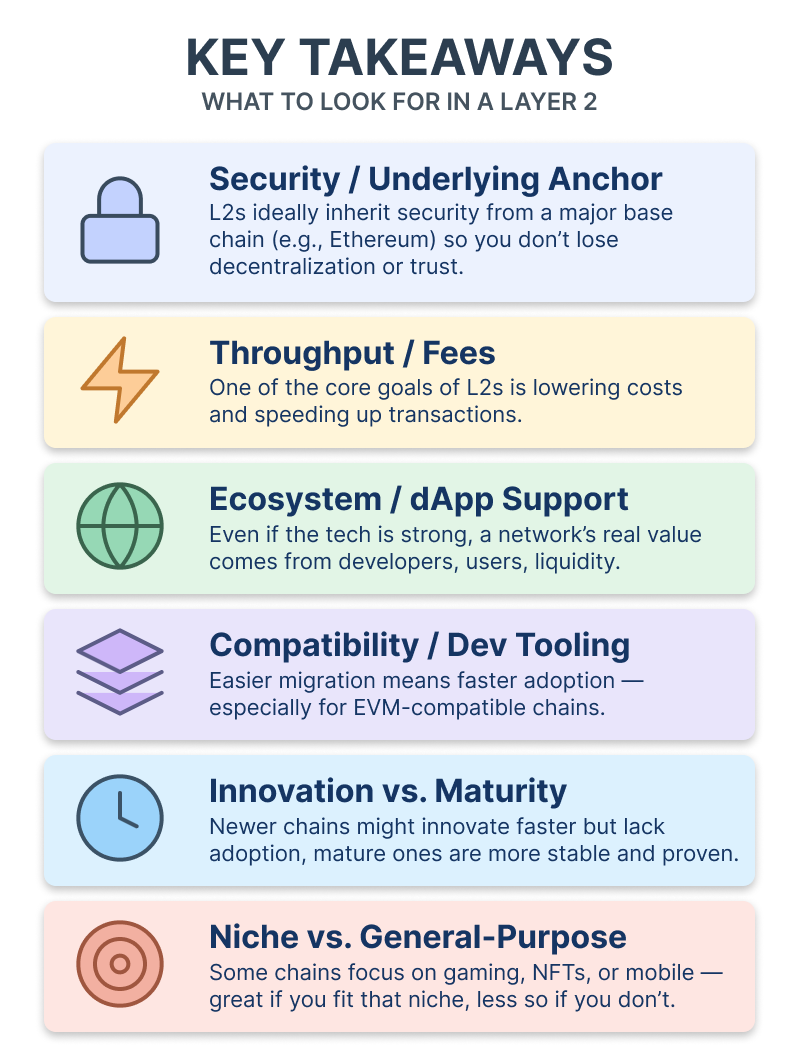What is a Layer 2 (L2) network?
As blockchain adoption continues to grow, the demand for faster, cheaper, and more efficient transactions has never been higher. Enter Layer 2 (L2) networks — scaling solutions built on top of Layer 1 blockchains like Ethereum that aim to improve performance without compromising decentralization. By processing transactions off-chain and settling them back to Ethereum, these networks drastically reduce gas fees and increase throughput. But not all L2s are created equal. From optimistic rollups to zero-knowledge proofs and sidechains, each network offers a unique take on scalability, security, and user experience.
Below, we’ll explore some of the leading L2s (and a few L2-adjacent chains) shaping the future of Web3.
What is scaling?
At its core, the whole point of Layer 2s is to make Ethereum faster, cheaper, and easier to use — without breaking the security and decentralization that make it valuable in the first place. This challenge is called scaling, and it’s been Ethereum’s biggest bottleneck since launch. Scaling means increasing transaction throughput while reducing costs, ideally without sacrificing security or user trust.
Ethereum’s base layer (Layer 1) prioritizes decentralization and security, but that makes it slow and expensive when millions of users pile in. Layer 2s and other scaling solutions step in to handle more activity off-chain or in parallel, then post the essential data back to Ethereum. The trick is doing that efficiently — and safely.
There isn’t one single way to scale Ethereum, which is why we now have multiple categories of networks taking different routes toward the same goal. Broadly, these break down into five main groups: Optimistic Rollups, ZK Rollups, Sidechains, Hybrid or Alt-L1s, and Experimental models. Each group handles computation and verification differently, and even within the same type, projects compete through design choices, governance structures, or community focus.
Types of Scaling
Optimistic Rollups are the most battle-tested L2s today. They assume transactions are valid by default and only check if someone disputes them later. This makes them efficient and cheaper but slower to finalize. Arbitrum, Optimism, and Base all fall into this group — same foundation, different execution. Optimism created the OP Stack, which other chains like Base and Mode have adopted, while Arbitrum runs its own tech stack called Nitro.
ZK Rollups take the opposite approach, using cryptographic proofs (zero-knowledge proofs) to verify every transaction upfront. They’re faster to settle and more secure in theory, but far more complex to build. Projects like zkSync Era, Polygon zkEVM, Linea, Scroll, and Immutable zkEVM are pushing this frontier — each with its own trade-off between performance, cost, and EVM compatibility.
Sidechains run alongside Ethereum but operate independently, using their own consensus mechanisms and validators. They offer cheap and fast transactions, but since they don’t rely on Ethereum for security, users must trust their validator set. Polygon PoS, BNB Smart Chain, Fantom, and Gnosis are the biggest examples — all EVM-compatible but very different in decentralization and community ethos.
Hybrid or Alt-L1s blur the line between Layer 1 and Layer 2. These networks started as independent chains but now integrate deeply with Ethereum, sometimes via rollups or bridges. Think Celo, Rootstock, Syscoin, or Avalanche — each with its own consensus and vision, yet orbiting Ethereum as a key hub.
Finally, Experimental Models are the wildcards — the chains testing new architectures, app-specific rollups, or economic systems that don’t fit neatly into existing categories. From Blast and Berachain to Story, Fraxtal, and Abstract, these projects push what a Layer 2 can even mean, whether that’s yield-bearing bridges, meme economies, or modular, composable frameworks.
Every one of these scaling types approaches Ethereum’s challenges from a slightly different angle — and together, they form the eclectic, creative network of chains we now call the “Layer 2 ecosystem.” Let’s look at how each category actually works.

Layer 2 Ecosystems
Optimistic Rollups
Optimistic rollups assume everything is valid unless proven otherwise. They post compressed transaction data to Ethereum and only run expensive computations when someone challenges a transaction. This “innocent until proven guilty” approach makes them efficient, but also slower to finalize — withdrawals can take up to a week.
Examples: Arbitrum, Optimism, Base, Mode, opBNB
These networks all use the same underlying concept but differ in governance and stack architecture. Optimism pioneered the OP Stack, a modular open-source framework that Base (Coinbase’s chain) and others like Mode and opBNB now use. Arbitrum, meanwhile, built its own tech stack (Nitro) that focuses on throughput and compatibility. Functionally, both types are fast and cheap — but Optimism leans more collaborative, while Arbitrum leans more independent.
In short: Optimistic rollups work great for most DeFi and social apps — fast to use, slow to exit, and easy to build on.
ZK Rollups
ZK rollups take the opposite approach: don’t assume anything — prove everything cryptographically. They use zero-knowledge proofs to verify all transactions instantly, allowing for faster withdrawals and higher security. The downside? Complex math and heavy proving costs make development slower and more expensive.
Examples: zkSync Era, Polygon zkEVM, Linea, Scroll, Immutable zkEVM, Manta Pacific, Hemi
Even within ZK rollups, approaches vary. zkSync emphasizes user experience and native account abstraction. Polygon zkEVM aims for bytecode-level EVM equivalence (Ethereum code works out of the box). Linea focuses on developer tools and ties tightly into ConsenSys’ ecosystem (MetaMask, Infura, etc.). Scroll has earned respect for its patient, research-first rollout, while Immutable zkEVM customizes Polygon’s tech specifically for gaming.
In short: ZK rollups are faster and more secure in theory, but they’re still maturing. Some analysts expect them to surpass optimistic rollups in the long run.
Sidechains
Sidechains are the “we built our own blockchain, but promise we’re compatible” approach. They run parallel to Ethereum with their own validators, consensus, and often cheaper gas. The tradeoff is that their security depends on their own network, not Ethereum’s — so trust in a sidechain depends on trust in its validators and consensus mechanism.
Examples: Polygon PoS, BNB Smart Chain, Gnosis, Fantom, Palm, Canto (originally)
Polygon PoS remains the most successful sidechain, onboarding millions before evolving into a broader multi-chain ecosystem. BNB Smart Chain took the same EVM formula and plugged it into Binance’s exchange empire — fast, centralized, and massive. Gnosis Chain and Fantom cater more to DAOs and independent DeFi, while Palm focused on NFTs and digital art. Canto started as a sidechain too, experimenting with Contract Secured Revenue (CSR) before pivoting to other directions.
In short: Sidechains scale by going solo. They trade a bit of Ethereum’s trust for flexibility and speed.
Hybrid / Alt-L1s
Then there are networks that aren’t quite L2s but want to be part of the conversation. These are Layer 1 chains that integrate EVM compatibility, bridges, or shared tooling with Ethereum. Some use their own consensus but connect deeply enough to be part of the “Ethereum orbit.”
Examples: Celo, Rootstock, Syscoin, Core, Avalanche, Kaia (formerly Klaytn), Telos EVM
Rootstock merges Bitcoin’s hashpower with EVM smart contracts — basically “DeFi for Bitcoin.” Syscoin takes a modular route, combining Bitcoin-style security with rollup infrastructure. Celo recently pivoted from mobile-first L1 to Ethereum L2, focusing on accessibility. Avalanche uses subnets (custom blockchains) that can mirror Ethereum environments. Kaia and Telos are corporate or EOS-origin chains that adopted EVM to stay relevant.
In short: Hybrid and Alt-L1s aren’t pure rollups — they’re “Ethereum-adjacent,” each with their own quirks and crossover appeal.
Experimental & Unique Models
Finally, we have the experimental types — chains and rollups trying weird, ambitious, or niche ideas that don’t fit anywhere else. These often test out modularity, gaming, identity systems, or entirely new forms of consensus.
Examples: Blast, Berachain, Degen, Story, Sonic, Abstract, Fraxtal, Unit Zero, Ink, Forsaken, Gravity, Godwoken
Blast brought auto-yield to L2s (bridge funds earn interest by default), a clever but controversial mechanic. Berachain runs on memes and a triple-token economy built in Cosmos. Degen is Base’s community chain full of memecoins and chaos. Sonic builds for games with Solana-style speed. Story experiments with app-specific rollups for social protocols, while Fraxtal integrates liquidity incentives directly into the chain. Projects like Ink and Abstract explore rollups-as-a-service for anyone to launch their own network, while Gravity and Godwoken build bridges between ecosystems like Cosmos and Nervos.
In short: These projects stretch the definition of “Layer 2.” Some will fade, others might shape the next evolution of Ethereum scaling.

Layer 2 Use Cases and Personal Preferences
At the end of the day, the “best” Layer 2 isn’t the one with the flashiest tech or the biggest airdrop — it’s the one that fits what you’re actually trying to do. Some users want the cheapest gas possible for small transactions, others want the tightest Ethereum integration, and a few just want to experiment with the newest chains before everyone else gets there.
Each network has its own trade-offs between security, cost, ecosystem maturity, and developer culture. Whether you’re building a DeFi protocol, minting NFTs, or just trying to bridge tokens around, it helps to know where each chain shines.
Here’s a quick reference table to help you decide which ecosystem might suit your goals best:

No single chain does everything perfectly. Some (like Arbitrum or Polygon) are reliable and battle-tested; others (like Blast or Berachain) are experimental playgrounds that might define the next era of crypto infrastructure — or fade just as quickly.
The key is to match your needs with the chain’s strengths:
- For security and decentralization, consider ZK rollups like Polygon zkEVM or zkSync.
- For speed and low fees, try Optimistic rollups like Base or Arbitrum.
- For experimentation or niche ecosystems, sidechains and hybrids like Celo or Fantom are still worth exploring.
In the end, Ethereum’s scaling landscape isn’t just one race — it’s a whole multiverse of approaches, each carving out its own place in web3’s future.
The Big Picture
Across all these networks, a few themes stand out. Optimistic rollups like Arbitrum and Optimism dominate current adoption, while ZK-rollups such as zkSync Era, Polygon zkEVM, and Scroll represent the future of fast, secure scaling. Sidechains and EVM-compatible chains like BNB Smart Chain and Gnosis remain popular for their low fees and mature ecosystems. Meanwhile, niche players like Palm, Manta Pacific, and Immutable zkEVM are proving that L2s can specialize beyond finance — into gaming, privacy, and creativity.
The Layer 2 landscape is no longer just about scaling Ethereum. It’s about reimagining how entire digital economies can interact. Whether you’re a developer, investor, or casual user, understanding these networks is key to navigating the next wave of Web3 innovation.

Thank you for checking out our article on Scaling Ethereum with Layer 2 Networks and Ecosystems! Don't forget to download Enkrypt for a seamless web3 multichain wallet experience. We would love to hear from you on our social media about any guide suggestions you have for the future. Also, if you enjoy using mobile cryptocurrency wallets, give our MEW Mobile app a try, it's available on both iOS and Android platforms!

